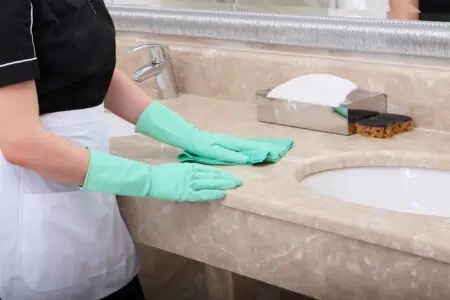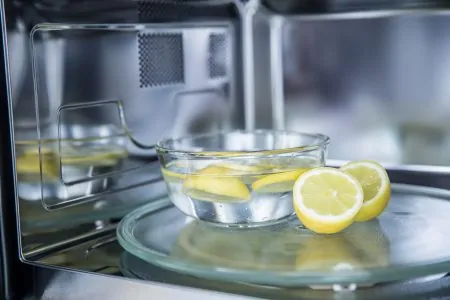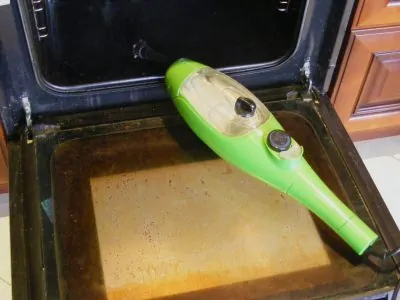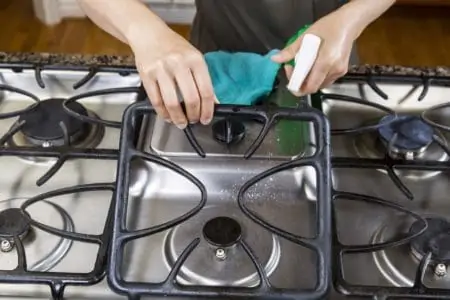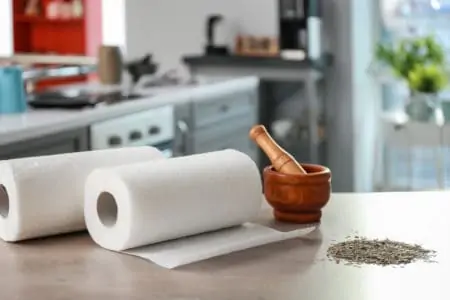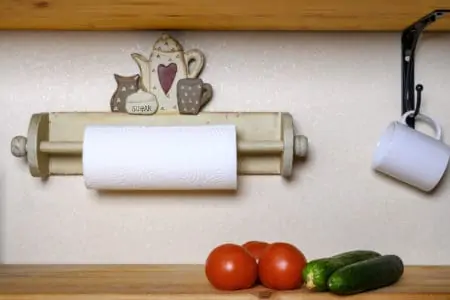When you spill something on your marble surface, it’s vital that you clean it up right away. Marble is a porous surface that stains easily, especially when it isn’t sealed properly.
While it can be tricky, we’ll show you how to remove stains from marble with or without a poultice. We’ll also share when the best time to hire a professional is — some stains are just too stubborn to remove!
Keep reading for the best methods for keeping this natural and timeless stone in mint condition.
Key Takeaways
- Act fast when spills occur on marble surfaces, as marble is porous and stains can set quickly.
- Use a poultice to remove stubborn stains from marble by applying it to the stain, covering with plastic wrap, and allowing it to set for 24 to 48 hours before removing it.
- Avoid using acidic or harsh cleaners, such as bleach or vinegar, on marble surfaces, as they can cause damage and etching.
- Protect marble surfaces by sealing them regularly, using pH-neutral detergents, and placing protective barriers like coasters and placemats to prevent staining.
Does Marble Stain Easily?
Unfortunately, yes. Marble does stain easily because it’s a naturally porous material. Marble also needs to be resealed regularly, roughly every six months.
If the surface isn’t sealed, liquids will penetrate the marble, leaving behind a stain. Marble is particularly vulnerable to acidic ingredients such as tomatoes, mustard, citrus, and vinegar. But clear liquids, like oil and water, can also leave permanent stains.
Top Tip
The most important way to prevent stains on marble is by ensuring it’s always dry. Don’t leave wet items, like a hot mug (which can cause condensation) or wet cloth, on the surface, as this can leave stains. Clean up spills immediately and dry the counter thoroughly.
What to Use to Clean Stained Marble
When it comes to cleaning marble, it’s essential that you have the right kind of products. Here are our top recommendations for what to use when cleaning this surface:
- Mild dish soap: What you’ll use most commonly for cleaning marble is mild dish soap. Make sure that it’s pH-neutral and non-abrasive. If you don’t use a pH-neutral detergent, you could be left with new soap stains! Simply mix soap and water in a spray bottle and clean the marble with a soft microfiber cloth.
- Hydrogen peroxide: Twelve percent hydrogen peroxide is suitable for cleaning organic stains, like food and drink.
- Ammonia: A few drops of ammonia can help blast stains away.
- Acetone or mineral spirits: These two ingredients are handy for removing oil stains.
- 0000-rated steel wool: For water stains and etching, you can buff the surface gently with 0000-rated steel wool.
- Rubbing alcohol: Rubbing alcohol can disinfect, remove stains and shine up marble surfaces.
- Cornstarch or baking soda: Cleaning with baking soda or cornstarch can pull stains out from within the marble thanks to the powder’s absorbent quality.
- Commercial marble stain remover and cleaner: You can also buy a commercial marble cleaner if you want something pre-measured and easy to use. Our recommendations include Granite Gold Shower Cleaner, Supreme Surface Treatment, or Supreme Surface Daily Stone Cleaner.
- Poultice: One of the most effective methods for removing marble stains is using a poultice. In the next section, we’ll share exactly how to clean stained marble with a poultice.
Warning
When cleaning marble, avoid acidic cleaners, glass cleaners, bleach, lemons, gritty cleaners, and abrasive sponges.
How to Remove Stains From Marble With a Poultice
Since marble is porous, stains can set quickly, deep into the surface. The most effective way to remove them is by pulling them out with a poultice. We’ll share the basic steps for carrying out this method.
Remember that you can buy a poultice that is either pre-mixed or requires a mixing ingredient, such as hydrogen peroxide. You can also make your own poultice. For instance, a 2:1 ratio of baking soda and hydrogen peroxide is a DIY poultice.
- Time: 20 minutes (plus waiting time).
- Difficulty: Easy.
What You’ll Need
- Poultice.
- Mixing ingredients for poultice (if necessary).
- Microfiber cloth.
- Marble surface cleaner.
- Plastic wrap.
- Masking tape.
- Spoon.
- Container.
- Paper towels.
- Plastic scraper.
- Sharp knife.
1. Clean the Marble Surface
Using your preferred cleaner, give your marble a quick wipe-down to ensure there is no dirt or debris. This can also help remove as much of the stain as possible. Dish soap and water is great, or you can use a commercial marble cleaner.
2. Prepare the Poultice
Read the instructions on your store-bought poultice to see if it needs to be mixed. If so, create a paste in a separate container. The consistency should be creamy, like peanut butter.
If you are making your own poultice, do so now.
3. Apply the Poultice
Use a spoon to spread the poultice evenly over the stain. Cover the poultice with plastic wrap and tape it down with masking tape.
Use a sharp knife to create holes in the plastic — this allows the poultice to breathe, so it doesn’t stay completely damp. You want it to harden over time.
4. Let It Set
Leave the poultice on the stain for 24 to 48 hours, depending on the severity. Scrape it off using a plastic scraper or credit card.
5. Clean the Area
Gently wipe the area with paper towels to remove residue. Keep wiping to remove all residue. Wait a few hours for the marble to 100 percent air dry. If the stain remains, repeat the above steps.
How to Get Stains Out of Marble
We’ll walk through the best way to remove specific stains, such as coffee, rust, mold, and more. While a poultice might be the answer to many of these stains, there are some other hacks to try, too.
Before removing any stains, make sure to wipe the surface with a cleaner and a soft cloth to remove as much of the stain as possible.
Coffee, Tea, or Wine Stains
The poultice will work wonders on organic marks, like tea or coffee stains. But another thing you can try is hydrogen peroxide.
- Dampen gauze: Dampen a piece of gauze with hydrogen peroxide — make sure it’s wet but not soaking.
- Apply: Cover the stain with gauze. Secure plastic wrap over it. Put a heavy object, like a dictionary, on top.
- Wait: Leave the hydrogen peroxide gauze on the stain for 24 to 48 hours.
- Wipe: Wipe the area with paper towels. If the stain persists, repeat the process.
Be Careful
If your marble is dark or black, test this in an inconspicuous spot, as hydrogen peroxide can have a bleaching effect. This method might be best for white or light-colored marble.
Oil-Based Stains
Oil-based yellow stains are best removed with a poultice. However, you can also mix ammonia and warm water together.
- Dilute ammonia: Make a 1:32 ratio of ammonia and water (for example, ½ cup per gallon of water).
- Clean the surface: Using either a mop or a cloth, clean the area.
- Rinse: Rinse the surface well with a damp mop or sponge.
- Dry: Dry the area with a soft towel.
Rust Stains
To remove rust stains, we recommend using a poultice. You can find poultices made specifically for rust, such as Tenax TeRust Rust Remover. On the other hand, you can make your own using one cup of hydrogen peroxide and two cups of baking soda.
Follow the instructions highlighted in the How to Remove Stains From Marble With Poultice section for the best results.
If the above method doesn’t work, call a professional.
Hard Water Stains
Using a commercial marble cleaner can help to remove hard water stains. You can gently scrub the marble with 0000-rated steel wool, which will buff away the stain.
Ink and Paint Stains
It’s best to remove ink and paint stains using a poultice. Ink and paint can quickly sink deep into the marble, so using a poultice to pull it out is often the only way. After you’ve used the poultice, rinse the area with warm water and soap to remove the poultice residue.
Food Stains
If you have marble kitchen counters, you know they’ll be no stranger to food stains. Things like curry sauce, tomatoes, and oil can leave behind stubborn stains on marble. The best method for removing them is by cleaning the marble immediately with warm soapy water or a commercial marble cleaner.
However, if the stain has set, try mixing 12 percent hydrogen peroxide with a few drops of ammonia. Spritz the stain, and leave for a few minutes before wiping with a soft cloth.
If the food stain is oil-based, mix soapy water and a few drops of mineral spirits or acetone.
Keep in mind that a poultice will work on these stains if the above methods don’t work.
Mold and Mildew
If you have marble in your bathroom, mold, and mildew might be frequent visitors. You can try a commercial product such as StoneTech Mold and Mildew Stain Remover to remove it.
If you want to make your own spray, combine equal parts hydrogen peroxide and water before adding a few drops of dish soap.
Apply the cleaner to the mold and mildew for up to 30 minutes before wiping well.
Etching
Etch marks occur when something — usually acidic — has broken down the marble’s surface. To remove etch marks, the best thing to do is to polish the marble. You can do so using a marble polishing powder or compound.
You can also use etch remover powder, such as MB-11 Marble Touch-Up. Whatever product you go for, read the instructions carefully.
However, we highly recommend hiring a professional to polish the marble. They will use the most effective yet safest products to avoid damaging the surface.
Professional Marble Stain Removal
While you know how to clean stained marble, you’re not exactly an expert in it. So if you’re feeling overwhelmed or the methods aren’t working, it’s time to call in the professionals.
Professionals are particularly helpful when it comes to stubborn stains, like rust, mold, or paint — as well as removing etch marks.
You should also call in professionals to polish your marble. While you can buy a product and do it yourself, fixing mistakes can be super expensive. This is best handled by a professional.
Depending on who you hire, most companies can clean and restore marble, removing all evidence of stains. They’ll also polish and reseal the marble, preventing future stains.
They’ll also advise how to maintain your marble: the best practice for avoiding stains. While there’s no one size fits all approach, they will analyze your marble and the stains before deciding on the best cleaning method. They can use a variety of options, including their very own poultice.
To find a professional marble cleaner, simply look up “professional marble cleaner” + your local area. You will come across search results that suit your situation. Always read reviews to make sure the company you find has a good reputation!
How to Protect Marble From Staining
Marble stains aren’t the easiest eyesore to remove. If you’ve opted for marble countertops, tables, floors, or bathroom features, it’s important to protect your marble. Here’s how you can avoid stains in the first place:
- Act fast: When you spill anything on marble — even water — clean it up right away. The longer you leave a substance on marble, the more likely the stain will set. Marble is super porous, so don’t leave the surface wet.
- Seal the deal: Sealing your marble is absolutely essential to preventing stains. Marble is naturally porous, allowing stains to set quickly. You should aim to reseal your marble every six months or maybe even more frequently. You can do this yourself or hire a professional.
- Don’t air dry: With other surfaces, we can let water air dry. But marble likes to absorb water and whatever cleaning product you use alongside it. Always dry marble with a towel or cloth.
- Mild detergents only: pH-neutral detergents are a must-have for cleaning marble. They are the most gentle and won’t add new stains. While this means it might be harder to remove stains, you know you’re not causing any extra damage to your marble. For instance, you must avoid cleaning with vinegar, citrus cleaners, bleach, or undiluted ammonia.
- Dust and sweep: Dust or sweep marble surfaces every day. When debris lays on a marble surface, it can quickly become etched into the stone, causing new stains. If you have marble floors, ensure the vacuum you use is suitable and won’t cause scratches.
- Protect the marble: Use coasters, placemats, potholders, rugs, and other protective surfaces on your marble countertop or floor. These items will create a protective barrier and prevent stains.
- Remember, acid stains: Avoid letting anything acidic directly touch marble. This includes vinegar, lemons, tomatoes, and acidic cleaners.
